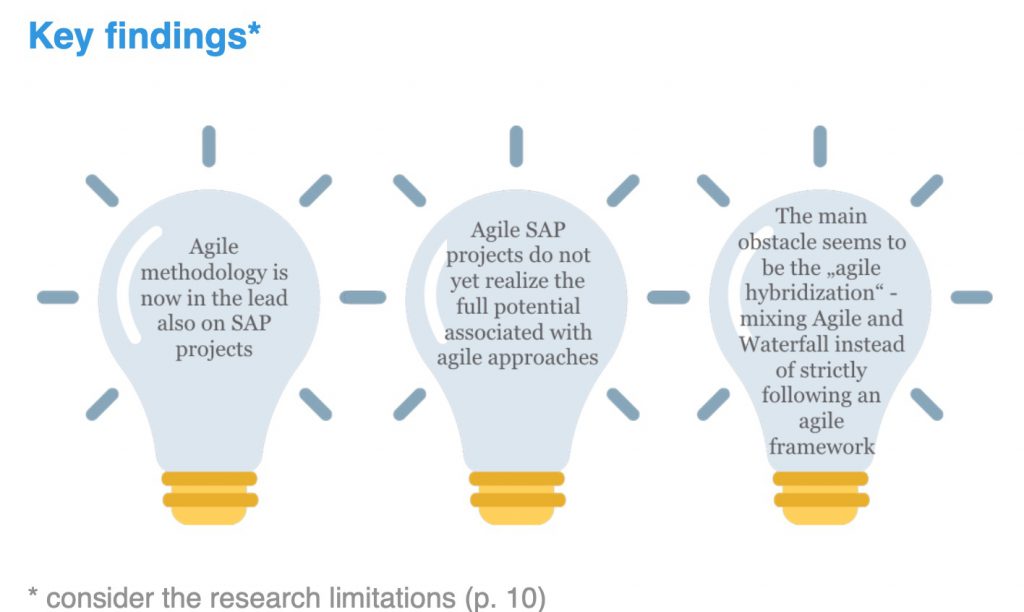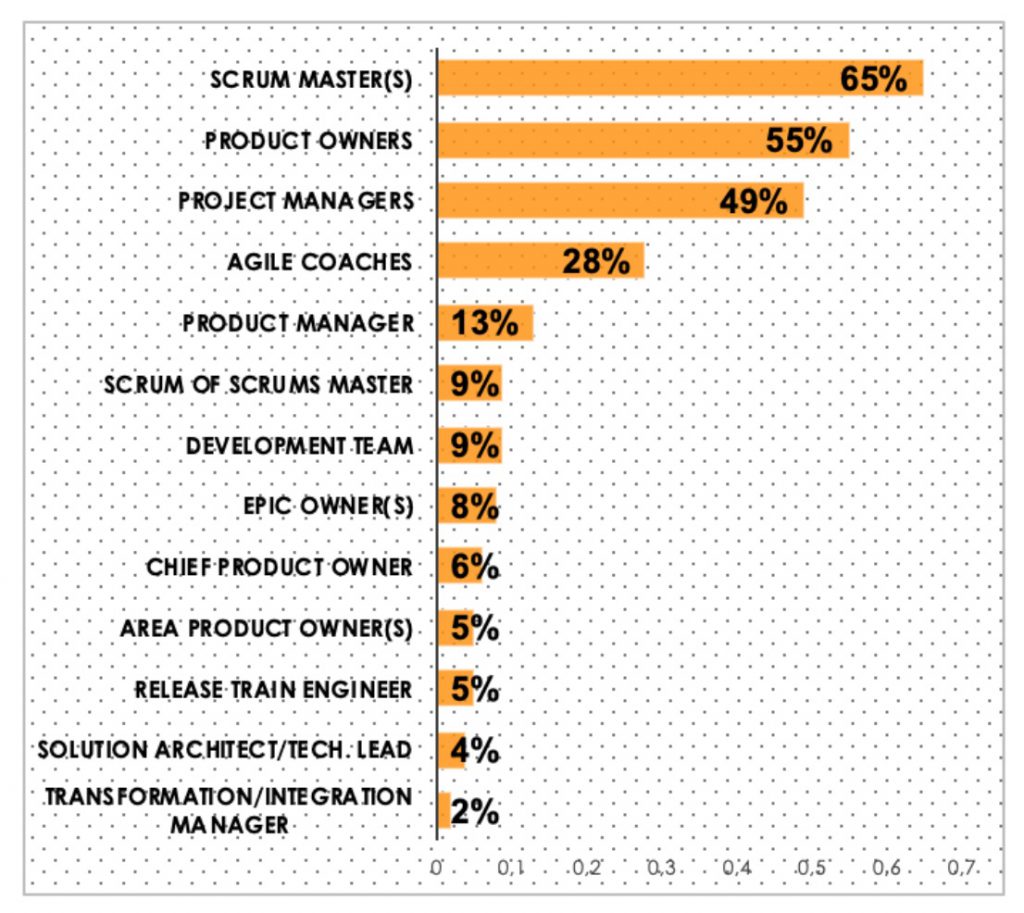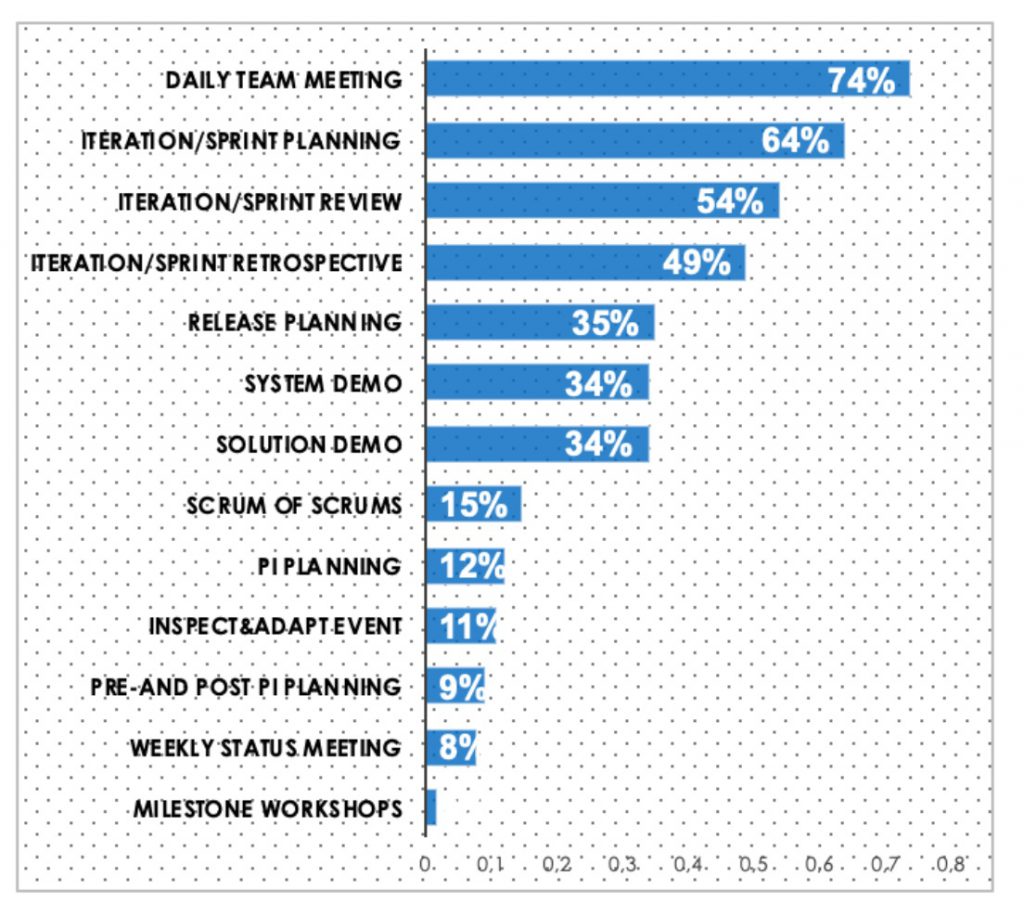X

AGILE SAP DELIVERY: SURVEY 2019
EXECUTIVE SUMMARY – download PDF
Since decades SAP projects were considered the most long-running, budget und resource consuming IT projects at big and mid-size enterprises. They were usually planned years in advance, executed according to the plan following the Waterfall methodology. Time, budget and quality were often getting out of hand and the projects went live months or years later than originally planned.
Since the acceleration of SAP innovation cycles and the introduction of quarterly upgrades for SAP on-premise software some companies started to look for a project methodology which helps to increase the efficiency and the speed of SAP projects. At the same time agile frameworks such as e.g. Scrum, SAFe, LeSS gained more and more attention by proving their advantages in other IT areas such as e.g. decreased time-to-market, high customer and employee satisfaction, high quality and less defects.
The purpose of the this survey is to explore the current state and advantages of the Agile Delivery in the context of SAP implementation, upgrade, conversion and transformation projects.

DEMOGRAPHICS
The geographical focus of this survey was Europe, whereby the most respondents were employed in one of the following countries: Germany, Netherlands, France, Belgium, Italy, Switzerland, Austria, Portugal, Denmark, Finnland, Sweden, Norway, UK, Irland, Poland, Romania, Slovenia, Slovakia.
We collected responses from targeted individuals who had experience with SAP projects in the current or the past role as an SAP Consultant, SAP Project or Program Manager, Agile Coach or a Scrum Master for SAP expert teams.
The respondents were from a diverse set of organization sizes and industries. However the highest number of responses were coming from larger organizations (59% of respondents from organizations of more than 10,000 people). 57% came from one of the following industries: Consulting, Chemical/Pharma, Automotive, SW development, Retail.

USED METHODOLOGIES
55% of respondents have applied an agile approach on the last SAP project. Only 20% of respondents have used the Waterfall approach. The remaining quarter used a hybrid approach meaning that some elements were taken from an agile and some from the Waterfall methodology.
The most widespread agile framework for SAP projects in this survey is Scrum (66% of respondents). Scrum is a framework which describes the rules and boundaries for a single team of up to 9 people and does not cover interactions between multiple teams and the organization of multi-teams projects. We may conclude from these results that an agile approach was mostly used to arrange the work for single teams and not to orchestrate entire SAP projects with multiple teams.
SAP Activate (12% of respondents) was the second and SAFe (10% of respondents) (Scaled Agile Framework) the third popular framework for SAP projects, followed by Scrum@Scale (2%), ASAP (2%), LeSS (1%) and Nexus (1%). In contrast to Scrum these frameworks give guidance for the cross-team alignment for big projects. Their usage on SAP projects is still quite low in comparison to the general surveys not restricted to SAP projects*.

WHY A CERTAIN FRAMEWORK WAS CHOSEN?
Below are the frequently given answers to the above question regarding the motivation, previous experience, knowledge and the role of outside advise that let to the decision of introducing an agile approach or choosing a specific framework for a SAP project.
– internal motivation, good previous experience and knowledge
- „the agile way helps the team to deliver better and faster“
- „flexibility to deploy changes“
- „fast results required, scope not clear“
- „well known and easy to follow framework“
- „light-weight framework“
- „one of the most known frameworks“
- „to reduce the time to market, get fast feedback and to have a “standardized” way of working“
- „scalable for big projects with several E2E processes, cross-functional processes and interfaces“
- „based on experience that worked best in the past“
- „just trying a different methodology“
– influencer from outside the company, external advise
- „it was recommended by SAP“
- „recommended by a consulting company“
– motivation unknown, management decision
- „Program Management decision“
- „chosen by Project Steering Committee“
- „given by Service Owner“
- „company strategy“
- „all teams use this framework since years“
- „standard framework in our company“
AGILE PRACTICES: ROLES
As Scrum is stated to be the most used agile framework in the context of SAP projects it is consequent that its roles – Scrum Master and Product Owner are also the most widespread. However, when comparing agile and hybrid projects (79% together) to projects where the roles of Scrum Masters and Product Owners (55-65%) are introduced you can deduce that only about 70% of projects which should have these roles indeed have them. Also the deployment rate of the typical SAFe and Scrum@Scale roles is below the deployment rate of the SAFe and Scrum@Scale frameworks. Further observation is that the role of Project Manager persists in 49% of SAP projects even though it contradicts with agile frameworks.

AGILE PRACTICES: EVENTS
The statistics on agile events follow the same trend as those for agile roles: (except of the Daily Team Meeting event) they are „underused“. While the Iteration/Sprint Review and Iteration/Sprint Retrospective are the mandatory and essential events of all agile frameworks they are applied in only 49-54% of projects but should be applied in about 80% of projects stated to be hybrid or agile. Apart from agile events some traditional waterfall events are still in place: weekly status meeting, milestone workshops.

AGILE PRACTICES: ARTIFACTS
On the contrary to agile roles and events, the main agile artifacts originated from Scrum – Product Backlog, Sprint Backlog are constantly used across agile and hybrid SAP projects. Also the Scrum/Kanban Board and the Definition of Done are used nearly in all non-purely-waterfall projects.
The digital usage of the artifacts is significantly higher than the analog usage.

PROJECT SUCCESS
Most of the respondents (60-67%) who were on agile and hybrid SAP projects found that the project performance in terms of meeting the deadlines and customer expectations, cross-team alignment and team happiness were acceptable but not outstanding good. About 30% of the respondents stated that meeting customer expectations and team happiness were excellent and 16% of the respondents found team happiness and cross-team/cross-level alignment poor.
On the one hand these results confirm the main benefits of an agile customer centric approach: high satisfaction of customers and teams. On the other hand, you see that these benefits have been achieved in a relatively small number of projects. This leads to the conclusion that current agile practices have promising results however there is space for improvement.
Encouraging is the fact that the majority (72% of respondents) would recommend an agile approach for SAP projects and only 8% of the respondents would not. Despite the fact that the success metrics tend to be in the middle range, this recommendation proves a good overall experience with agile SAP projects.

LIMITATIONS
As any research this survey has several limitations which need to be considered when looking at the results.
Sample size
Given the fact that the number of people in Europe who are involved in SAP projects is huge (currently ca. 81,000 according to a LinkedIn search on spring 2019). Only 500 of them were randomly asked reaching out over LinkedIN to take part in this survey and only 100 of them have actually participated. The sample size is considered small and does not assure a statistical significance. Conducting this survey in larger sample size can generate more accurate results.
Formulation of survey objectives, questions and given answers
Even though we endeavoured to formulate the objectives, questions and answers of our survey as neutral as possible there is a possibility that the chosen formulations have attracted respondents who have affinity to the agile methodology and disinterested respondents who are Waterfall supporters leading to distorted results.
Limited scope
The survey questions did not cover neither all aspects of an agile and a waterfall approach nor all specifics of all agile frameworks. The focus was on the most widespread frameworks identified by other similar studies. To achieve a more complete picture further in-depth research is required.
Copyright Ⓒ 2018 Agilon GmbH. All rights reserved.